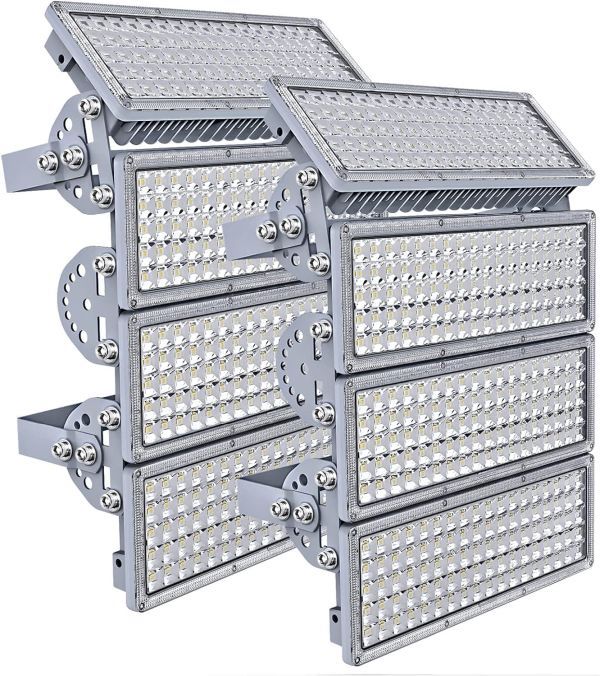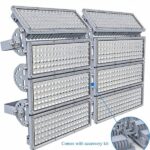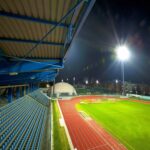800W LED football stadium lights




Reach out to us for a complimentary lighting design consultation
Power: 800W
Lumen: 112,000 lm
Luminous efficacy: 140 lm/W
Color temperature: 6500K
Beam angle: 25° / 45° / 60° / 90°
CRI: Ra>80
Contents
About this item
Powerful Illumination
Harnessing an impressive 800W of robust power, these LED stadium lights flood football fields with brilliant luminance, ensuring unparalleled visibility from every vantage point.
Exceptional Brightness
With a staggering lumen output of 112,000, these lights radiate an extraordinary level of brightness, evenly bathing the entire playing area in light to illuminate every moment of the game.
Efficient Lighting Performance
Achieving an outstanding luminous efficacy of 140 lm/W, these lights maximize energy utilization while delivering uncompromising brightness, presenting a smart and sustainable solution for stadium lighting needs.
Vivid Color Clarity
At a crisp 6500K color temperature, these lights emit a vibrant, natural white glow that enhances visibility and sharpness on the field, empowering players to perform at their peak regardless of the time of day.
Expansive Coverage
With a wide 120° beam angle, these stadium lights cast a broad swath of illumination, eradicating dark corners and ensuring consistent brightness across the entire playing surface for an optimal gaming environment.
Precision Color Rendering
Boasting a high Color Rendering Index (CRI) of Ra>80, these lights faithfully reproduce colors with exceptional accuracy, enabling players to discern details with clarity and enhancing their immersive gaming experience.

What are the maintenance requirements for stadium lighting installations?
Maintaining stadium lighting installations is crucial to ensure optimal performance, safety, and longevity of the fixtures. Maintenance requirements may vary depending on the type of lighting technology used (e.g., LED, metal halide) and the specific conditions of the sports venue. Here are some common maintenance tasks for stadium lighting installations:
Regular Cleaning
Dirt, dust, and debris can accumulate on lighting fixtures over time, reducing light output and efficiency. Regular cleaning of the fixtures, lenses, and reflectors is essential to maintain optimal performance. This may involve removing dirt and debris using compressed air or gentle cleaning solutions.
Inspection of Electrical Components
Periodic inspection of electrical components such as wiring, connectors, and junction boxes is necessary to identify any signs of wear, damage, or corrosion. Ensure all electrical connections are secure and free from moisture ingress to prevent electrical hazards.
Replacement of Lamps or LEDs
For traditional lighting sources such as metal halide or high-pressure sodium lamps, regular lamp replacement is necessary to maintain consistent light output and color temperature. LED fixtures have longer lifespans but may still require occasional LED replacement if individual diodes fail.
Checking for Damage or Wear
Inspect the fixtures, mounting hardware, and support structures for any signs of damage, corrosion, or wear. Pay particular attention to areas exposed to harsh weather conditions, such as outdoor elements and high winds.
Testing and Calibration: Periodic testing and calibration of lighting control systems, dimming controls, and sensors are essential to ensure proper functionality and performance. Verify that lighting levels meet recommended standards for different sports activities and events.
Upgrading and Retrofitting
Consider upgrading or retrofitting older lighting fixtures with more energy-efficient and technologically advanced options, such as LED retrofit kits or fixtures. This can improve energy efficiency, light quality, and overall performance while reducing maintenance requirements.
Compliance with Regulations
Ensure that stadium lighting installations comply with relevant industry standards, local regulations, and sports lighting guidelines. This may include requirements related to light trespass, glare control, and environmental impact.
Emergency Preparedness
Develop and implement an emergency maintenance plan to address unexpected issues such as power outages, equipment failures, or severe weather events. Ensure that necessary tools, spare parts, and backup systems are readily available to minimize downtime.
Training and Education
Provide training for maintenance personnel on proper procedures for cleaning, inspection, and troubleshooting of stadium lighting installations. Keep abreast of advances in lighting technology and best practices in maintenance to optimize performance and efficiency.
By implementing a comprehensive maintenance program and addressing potential issues proactively, stadium owners and operators can ensure that their lighting installations remain reliable, efficient, and safe for players and spectators alike. Regular maintenance not only extends the lifespan of the fixtures but also helps maximize the return on investment over time.
Can stadium lighting solutions be integrated with smart control systems?
Stadium lighting solutions can indeed be integrated with smart control systems. This integration offers several benefits in terms of energy efficiency, flexibility, and convenience. Here’s how stadium lighting can be integrated with smart control systems:
Energy Efficiency
Smart control systems allow for precise control over the intensity and timing of stadium lighting. This enables operators to adjust light levels based on the specific needs of different events, optimizing energy usage and reducing overall consumption.
Remote Monitoring and Management
Smart control systems enable remote monitoring and management of stadium lighting installations. Operators can access real-time data on energy usage, lamp status, and system performance, allowing for proactive maintenance and troubleshooting.
Scheduled Lighting Programs
Smart control systems allow operators to create customized lighting schedules based on event schedules, seasons, or specific user requirements. Lighting can be programmed to automatically adjust based on time of day, weather conditions, or occupancy levels.
Dynamic Lighting Effects
Some smart control systems offer dynamic lighting capabilities, allowing operators to create dynamic lighting effects for special events, performances, or entertainment purposes. This enhances the spectator experience and adds visual appeal to the venue.
Integration with Other Systems
Smart control systems can be integrated with other building management systems, such as HVAC and security systems, for centralized control and coordination. This streamlines operations and enhances overall efficiency.
Energy Monitoring and Reporting
Smart control systems typically include energy monitoring and reporting features, providing detailed insights into energy usage patterns and trends. This data can be used to identify opportunities for further optimization and cost savings.
Feel free to contact us regarding pricing inquiries and any additional information you may require. We’re here to assist you with all the details you need.
